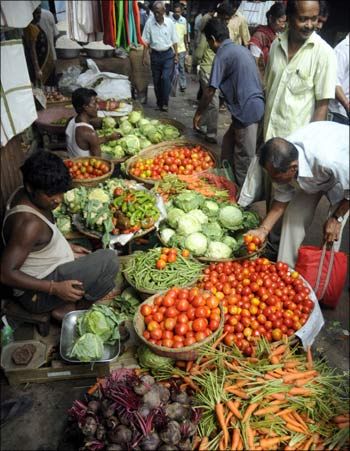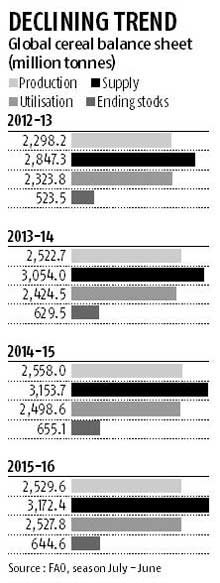 To exporters' relief, global food prices rebounded in October, due to an adverse impact of the El Niño weather effect on estimated winter harvest output.
To exporters' relief, global food prices rebounded in October, due to an adverse impact of the El Niño weather effect on estimated winter harvest output.
Data compiled by the Food and Agricultural Organization of the United Nations showed a four per cent jump in its Food Price Index, to average at 162 points, the sharpest increase since July 2012, though 16 per cent lower from the same month a year before.
El Niño had during the recent monsoon season affected 34 countries, including major agricultural ones like India, Brazil, Thailand, Ukraine, Indonesia and the US.
The winter harvest is expected to get affected in cereals, sugar and edible oil.
"Major food commodity prices rose in October, mainly spurred by weather-driven concerns about sugar and palm oil supplies and cereals.
Food prices might continue moving upwards on concerns of lower yield," said FAO in its latest report, issued on Thursday.
Its forecast is for world cereal production at 2,530 million tonnes (mt) in 2015, 4.7 mt less than projected in October and 28.4 mt (1.1 per cent) below the 2014 record. The revision was mainly the result of less buoyant expectation for maize crops in Asia and Europe.
In Asia, the decrease mainly concerned India (reduced by a million tonnes), to reflect lower than earlier anticipated planting for the kharif maize crop and unfavourable rain. In Europe, dry conditions are behind a 1.6 mt reduction of maize output prospects in Ukraine.
Similarly, FAO has cut its global rice production forecast by a further 1.6 mt since October, to 491.4 mt, about 0.6 per cent down from the already poor 2014 season. This is mainly on account of Thailand, where after a lingering drought that had already impaired the main crop, insufficient water in reservoirs is putting at risk the secondary crop.
 By contrast, the forecast for global wheat production has been increased by 1.4 mt since October to 736 mt, about three mt above the 2014 record. The monthly revision mostly reflects a higher production estimate in the European Union, which more than offset lower estimates for Australia and America, where insufficient rain and high temperatures are hampering yields.
By contrast, the forecast for global wheat production has been increased by 1.4 mt since October to 736 mt, about three mt above the 2014 record. The monthly revision mostly reflects a higher production estimate in the European Union, which more than offset lower estimates for Australia and America, where insufficient rain and high temperatures are hampering yields.
World cereal output in 2015-16 is now forecast at 2,528 mt, about 1.8 mt less than anticipated in October. Therefore, the forecast for world stocks at the seasons ending in 2016 has changed little since the previous month, at 638 mt, as reduced forecasts for maize inventory in India, the US and Ukraine were offset by higher ones in the EU.
The price of sugar saw the sharpest monthly increase since February, with the average price index up as much as 17.2 per cent or a 29 points jump in October, from the September level. The surge was largely driven by the weather, in Brazil, the world's leading producer, and reports of crop damage caused by excessive dryness in India, Thailand, the Philippines, South Africa and Vietnam.
FAO's vegetable oil price index averaged at 142.6 points in October, up 8.4 points (or 6.2 per cent) from September. The increase, after three months of decline, was primarily driven by higher palm oil prices.








 © 2025
© 2025